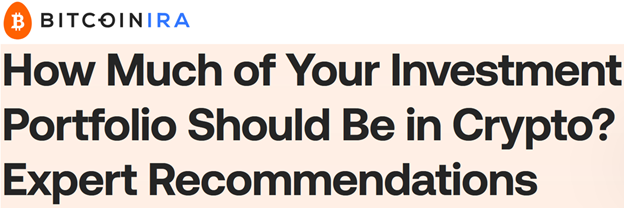What a Rate Cut Means for Your Crypto Strategy
Editor’s note: The Fed's getting ready to flood the system with money.
When all that fresh liquidity hits the markets, history shows it’s the smaller cryptos that can explode in value the most.
We’re talking gains as large as 1,204% … 2,324% … and even 17,862%.
Dr. Martin Weiss and Mark Gough recently held an emergency summit where they discussed how a new generation of coins could blow past Bitcoin and even Ethereum.
To listen in on their conversation … and see how you can get the names delivered to your inbox … click this link here.
But with just six days until the Fed is set to rock the financial landscape, we have to take this video offline at midnight tonight.
So don’t wait. Watch this video now before it’s too late.
 |
| By Jurica Dujmovic |
The U.S. Federal Reserve's upcoming meeting has crypto investors on edge. And for good reason.
Market expectations now exceed 80% for a 25-basis-point rate cut at its Sept. 16-17 policy meeting.
Even before Chairman Jerome Powell’s press conference starts Wednesday at 2 p.m. Eastern, we already know one thing.

That is, the Fed’s decision — whether to cut small, cut big or not cut at all — could reshape the investment landscape far beyond traditional markets.
The New Crypto Policy Landscape Sets the Stage
The environment heading into this Fed meeting is a lot different from previous cycles.
Two major policy shifts have transformed how cryptos interact with traditional monetary policy.
- America's Strategic Bitcoin Reserve, established earlier this year, created unprecedented government validation for digital assets.
- And new stablecoin regulations have turned what were once-experimental tokens into regulated financial infrastructure.
The U.S. government's Bitcoin holdings, now worth roughly $24 billion, represent more than just a policy statement.
They signal institutional acceptance that could amplify any Fed-driven market movements.

When the institution that prints dollars starts holding Bitcoin, it suggests a hedging mentality. One that retail investors should take seriously.
Meanwhile, stablecoin regulations have created another new dynamic. One where digital dollars directly compete with traditional savings accounts.
USD Coin (USDC), a stablecoin pegged to the greenback, yields 4.1%-4.7% through platforms like Coinbase.
That’s vastly more than traditional savings accounts that offer sub-1% returns. Which makes stablecoins like USDC increasingly attractive as Fed policy shifts.
What a Rate Cut Means for Your Crypto Strategy
If the Fed delivers the widely expected quarter-point cut, crypto investors should prepare for both immediate opportunities and longer-term strategic shifts.
The most direct impact will hit stablecoin yields, which form the backbone of many crypto earning strategies.
These yields aren't magic — they're essentially pass-through returns from U.S. Treasury securities that back regulated stablecoins.
When the Fed cuts rates:
- Treasury yields fall, and
- Stablecoin platforms will inevitably reduce their offered returns.
The current attractive rates of 4%-5% on digital dollars will shrink. However, those may still outperform traditional banking products.
This creates a timing consideration for investors currently earning yield on stablecoins.
Yes, rate cuts typically boost risk-asset prices. (Including crypto.)
But at the same time, they reduce the returns on the "safe" digital cash that many use as portfolio ballast.
Smart investors might want to lock in current yields where possible. Or prepare to reallocate as rates decline.
Bitcoin's Unique Position in a Cutting Cycle
Bitcoin faces a particularly interesting dynamic heading into potential rate cuts.
On one hand, lower interest rates typically benefit Bitcoin by reducing competition from yield-bearing assets and encouraging risk-taking.
Industry analysts suggest Bitcoin could reach $150,000 under the right macroeconomic conditions, with the first Fed rate cut potentially providing significant price momentum.
However, Bitcoin's new status as a government-held strategic reserve introduces unusual considerations.
The U.S. Treasury's Bitcoin holdings create both upside potential and downside risk.
Government ownership gives it legitimacy. But this also means Bitcoin could become entangled in fiscal policy decisions beyond pure monetary policy.
As an investor, you may want to treat your Bitcoin allocation differently than in previous cycles.
After all, it’s evolved from pure speculation toward something resembling digital gold. But with substantially more volatility.

Financial advisers continue recommending limiting crypto exposure to 1%-5% of total portfolios.
But within that allocation, Bitcoin's government endorsement makes it a reasonable core holding.
The Stablecoin Opportunity Window
Perhaps the most actionable opportunity lies in the evolving stablecoin ecosystem.
Recent legislation has provided needed regulatory clarity.
This has helped to transform stablecoins from experimental tokens into regulated financial products. Ones that can compete directly with traditional banking.
Institutions are already reallocating capital accordingly.
Goldman Sachs and BlackRock now manage billions in USDC-based strategies.
This signals that retail investors should take these products seriously.
The key insight here is that current high stablecoin yields represent a temporary arbitrage opportunity that will likely narrow as rates fall.
This creates several strategic considerations.
First, investors currently earning 4%+ on stablecoins should understand this won't last forever.
Second, the regulatory framework now allows for sophisticated yield strategies that layer different protocols to potentially earn higher returns, though with increased complexity and risk.
Most importantly, stablecoins now offer something unique: dollar-denominated assets that can be moved instantly, globally and without traditional banking friction.
As competition between crypto platforms and traditional banks intensifies, this functionality becomes increasingly valuable regardless of yield levels.
Preparing for Market Volatility
Recent employment data showed unemployment rising to 4.2%.
The recent (significant) downward revisions to job growth suggest the Fed may be cutting rates due to economic weakness rather than simply normalizing policy.
This distinction matters enormously for crypto investors.
- Rate cuts driven by economic strength typically benefit risk assets like cryptos.
- Rate cuts driven by economic worry can create initial volatility as investors sort out whether lower rates offset economic concerns.
With Bitcoin recently down over 13% from recent highs, the market may be pricing in some of this uncertainty.
Investors should prepare for increased volatility around the Fed meeting, regardless of the decision.
Current market positioning shows stablecoin reserves have nearly doubled compared to last year. This suggests significant dry powder is available for crypto re-entry if prices dip.
This setup creates opportunity for patient investors.
If the Fed cut triggers a temporary crypto sell-off due to economic concerns, then the substantial stablecoin reserves that sit on exchanges could fuel rapid rebounds once sentiment stabilizes.
3 Practical Investment Strategies
Given these dynamics, crypto investors should consider several practical approaches heading into the Fed meeting.
First, diversify your stablecoin exposure across multiple platforms to optimize yields while they remain attractive.
The regulatory framework now makes this safer than in previous years, though platform risk still exists.
Second, consider the timing of major crypto purchases or sales relative to the Fed decision.
If you're planning to boost your crypto allocation, wait for post-meeting volatility to provide better entry points.
If you're overweight crypto and want to rebalance, then consider taking some profits before potential volatility.
Third, pay attention to the international implications of U.S. crypto policy changes.
The dollar's continued strength in digital asset markets means Fed decisions ripple globally.
This potentially creates arbitrage opportunities across different crypto markets and stablecoins.
Looking Beyond September
The September Fed meeting represents more than just one policy decision.
It's likely the beginning of an easing cycle that will reshape crypto markets over the next year.
JPMorgan expects additional 25-basis-point cuts at subsequent meetings before pausing. This would potentially bring rates to 3.25%-3.5% by early 2026.
For crypto investors, this suggests a multi-stage evolution.
Initial rate cuts may benefit Bitcoin and risk assets but reduce stablecoin yields.
As the cutting cycle progresses, the focus will likely shift to which crypto assets and platforms can maintain attractive returns in a lower-rate environment.
The institutions now entering crypto markets — banks, asset managers and corporations — are building for this longer-term, lower-rate world.
As institutional flows accelerate over the coming months, you can get positioned to ride that wave.
The cryptocurrency market of late 2025 and 2026 may look very different from today's landscape, with …
- Regulated stablecoins serving as financial infrastructure …
- Bitcoin functioning as digital gold and…
- Entirely new categories of yield-generating crypto products that emerge to compete in a lower-rate environment.
The Fed's September decision is just the opening move in this larger transformation.
For those of you willing to stomach a little volatility now, the longer-term profit opportunities could be substantial.
Best,
Jurica Dujmovic
P.S. My colleague Mark Gough just released the names of three coins he believes could generate “Superstar” returns no matter what JPOW says at Wednesday’s presser.
To get your hands on this powerful research, click this link here.
But hurry — we’re taking down this video at midnight TONIGHT.

